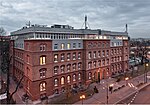Montelupi Palace

Montelupi Palace, also known as the Tarnowski Palace or the Palace on the Way (Polish: Pałac na Szlaku or Pałac Montelupich) is a 17th-century palace in Kraków, Poland. It was built for the Montelupi family, descendants of an Italian-born merchant Sebastiano Montelupi, banker in the court of King Sigismund III Vasa. The palace was later owned by the noble Tarnowski family and others. The palace is located at ul. Szlak 71 street (translated as on the Way) in the District of Stare Miasto close to the city centre. Even though the building is listed as monument since 1989 in the registry of the Lesser Poland Voivodeship, it has been neglected since 1998, while the Tarnowski family members continued their legal proceedings against the city for its private ownership.
Excerpt from the Wikipedia article Montelupi Palace (License: CC BY-SA 3.0, Authors, Images).Montelupi Palace
Szlak, Krakow Stare Miasto (Old Town)
Geographical coordinates (GPS) Address External links Nearby Places Show on map
Geographical coordinates (GPS)
| Latitude | Longitude |
|---|---|
| N 50.070277777778 ° | E 19.942222222222 ° |
Address
Pałac Tarnowskich
Szlak 71
31-153 Krakow, Stare Miasto (Old Town)
Lesser Poland Voivodeship, Poland
Open on Google Maps










